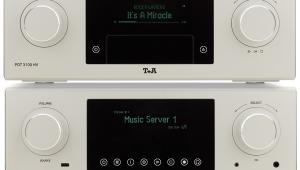Densen B 440xs (£3250)

Danish company Densen has updated its top CD player, the Beat 440, to include a coaxial digital input, so that its internal D-to-A converter and output stage can be used for an external source ‘like a Sonus system, a Squeezebox or another digital source’, to quote the company’s recent announcement of this latest B-440XS model.
Despite its slim profile and svelte cosmetic design, the player is quite a heavyweight at 8kg. Under the brushed aluminium casing its regulated power supply employs a 300VA transformer alongside substantial reservoir capacitors. Densen states that the digital and analogue stages, microprocessors, and front panel dot matrix display all have individual supply arrangements designed to avoid interference. Furthermore the B-440XS adds a socket for connection of Densen’s DNRG and 2NRG external power supplies, to further upgrade performance.
Densen uses its own control software for the disc transport, while circuitry includes Vishay metal film resistors. A stylish metal handset is supplied with a plug-top power supply for recharging its internal cells, but the layout of its myriad identically-sized buttons requires familiarisation. The button on the fascia, duplicated on the handset, labelled ‘Select’ reverses phase while ‘Status’ switches track/disc elapsed/remaining time.
SMOOTH OPERATOR
There’s a smooth, mellifluous character to the B-440BX that draws you in to the musical performance. The tonality is warm and inviting, its full-bodied bass delivery and silky high frequencies assuring easy listening. With Pink Floyd’s ‘The Happiest Days Of Our Lives’ the Densen delivered tremendous bass wallop, sounding the most dynamic and assured of all the players in this month’s group, without suggesting even the merest hint of stress during the track’s explosive thrills.
The modern pop recording of Adele was noticeably engaging as well, the B-440BX seeming to take the up-front, edgy production in its stride. It was similar to the Moon player in this respect, its smooth character removing the bite from Adele’s nasal, compressed ‘Rolling In The Deep’ vocal, and its bass power adding gravitas to the stomping kick drum on this track.
But its softening of hard edges spoiled the realism afforded by really good recordings. The texture of The Helicon Ensemble’s early instruments in the Vivaldi were better described by the Marantz, Primare and Cambridge players, as was the acoustic space in which the musicians were recorded. And the Patricia Barber recording sounded blurred and somewhat congested.
Originally published in the July 2011 issue



























































